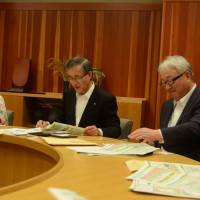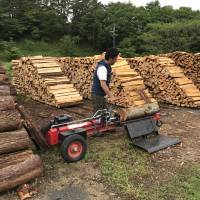The Japan Times Satoyama Consortium organized a two-day study tour in Okayama Prefecture in June to learn about creative efforts made by two cities, Maniwa and Bizen, to establish a sustainable and circulating society.
The consortium aims to help relevant parties promote their activities related to effective utilization of satoyama and satoumi — Japanese terms that respectively refer to woodlands in rural regions and coastal areas managed by people to maintain high biological productivity and diversity.
On June 8, the first day of the tour, participants visited Maniwa, which is in the north-central part of the prefecture. Forests cover around 80 percent of the land in the city.
What made the city stand out as a model of a self-sustainable community is the Maniwa Biomass Power Plant that generates much more electricity than the total amount used by the city's households. The surplus electricity is sold to four electric power companies.
The biomass power plant uses timber offcuts and sawdust from the cross-laminated timber plant run by Meiken Lamwood Corp. across the street, unused timber and thinnings collected from the local mountains and forests.
Seiichiro Higuchi, the executive director of Maniwa Timber Business Cooperative Association, explained that leaves and branches can also be purchased as fuel. "Not only logging and transport companies, but also property owners make money, motivating all related parties to take better care of the forests," he said.
The study tour also visited Maniwa Mayor Noboru Oota to learn about the city's policies that center around "satoyama capitalism," which refers to the economic strategy established on new values created by the usage of untapped natural resources, the same concept on which the vision of the Japan Times Satoyama Consortium is based.
Oota referred to the utilization and circulation of resources in the city represented by the biomass electricity generation as "large-scale satoyama capitalism," and the efforts made by each region within the city featuring the local characteristics and resources as "small-scale satoyama capitalism."
After lunch with the mayor at Nishikura, a restaurant located in a renovated sake storehouse on a historic street, the group visited the district of Chuka in the northeastern corner of Maniwa to see an example of "small-scale satoyama capitalism."
Naoto Akagi, president of an incorporated association named Ashitaka, led the group into a small room adjacent to the entrance of Tsuguro Kogenso, a public onsen (hot spring) lodge. Inside the room were two wood-fired boilers that heat the spring water that flows into large common baths.
He explained that firewood is brought in on trucks by mostly elderly area residents, who collect it from the land they own or that owned by the government. Most of the forests in the area had been neglected until the wood-fired boilers were installed at the inn.
"Now, people go in and manage the once-abandoned forests. Elderly residents are building links with younger generations through the work and they can also earn extra income from selling the firewood," said Akagi.
While managing the firewood supplies, Akagi's organization also produces iburigakko (smoked and pickled daikon radish), shiitake mushrooms, spicebush tea, essential oils and other products.
Unlike urban areas where most people work for one company, Akagi said that there are many small jobs in the countryside. "To connect people through such jobs and circulate money and resources within the region is the key to maintaining a vibrant community," he said.
He is also a board member of Maniwa Nariwai Juku, which is a two-year school that offers opportunities to learn about ways to live and work sustainably in rural areas. The 21 participants who entered the program this year all came to Maniwa from cities across Japan.
"Most of them are in their 20s or 30s. All of them are keen to start their lives in the countryside," said Vice Chairman Hiroo Komamiya.
Nahoko Yoshino, a board member, said, "The classes are held on weekends and participants stay overnight in public area facilities. The second half of the course is very practical. Participants actually plan their lives in the countryside by developing products using local resources or discussing regional issues."
The second day of the study tour in Bizen will be covered in a future satoyama article.
This series introduces municipalities and local companies promoting the beauty and excellence of deep Japan.





















With your current subscription plan you can comment on stories. However, before writing your first comment, please create a display name in the Profile section of your subscriber account page.